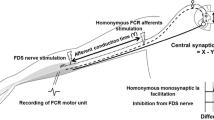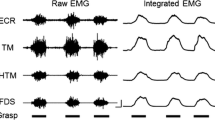Abstract
In this study the systematic modulation of wrist flexor muscle activity by imposed joint movement was examined. Ten subjects maintained a constant contraction level (25% of the maximum; trial duration: 20 s) in flexor carpi radialis while their wrists were perturbed with 50 different quasi-sinusoidal signals (frequency range: 0.5–9.5 Hz; amplitude: 0.3–4.2°). The frequency spectra of wrist position and the rectified and filtered electromyogram (EMG) were determined. The muscle activity was only weakly entrained to imposed movements of small amplitude and low frequency, as shown by a small peak in the EMG spectrum at the frequency of movement, while the most prominent peak in the spectrum was between 9 and 15 Hz, corresponding to the frequency range of physiological tremor. The entrainment of muscle activity increased markedly as the amplitude and frequency of the imposed movement increased, to the point of saturation of modulation and harmonic peaks in the spectrum. In parallel with this increase in entrainment, the 9–15 Hz tremor peak was progressively extinguished. The results are consistent with a coupled oscillator model in which the central oscillatory source(s) of tremor became fully entrained to the imposed movement at the highest amplitudes and frequencies. Such coupling depends on communication between the external forcing oscillator and the central oscillator(s), the I a afferent signal from the imposed movement being the most likely candidate to provide the entraining signal for the central oscillator(s).







Similar content being viewed by others
References
Allum JH, Dietz V, Freund HJ (1978) Neuronal mechanisms underlying physiological tremor. J Neurophysiol 41:557–571
Andrews CJ, Burke D, Lance JW (1973) The comparison of tremors in normal, parkinsonian and athetotic man. J Neurol Sci 19:53–61
Brown TIH, Rack PMH, Ross HF (1982a) Different types of tremor in the human thumb. J Physiol 332:113–123
Brown TIH, Rack PMH, Ross HF (1982b) Electromyographic responses to imposed sinusoidal movement of the human thumb. J Physiol 332:87–99
Burne JA, Lippold OCJ, Pryor M (1984) Proprioceptors and normal tremor. J Physiol 348:559–572
Cannon SC, Zahalak GI (1981) Reflex feedback in small perturbations of a limb. ASME Biomechanics Symposium AMD(43):117–120
Cathers I, O’Dwyer N, Neilson P (1999) Dependence of stretch reflexes on amplitude and bandwidth of stretch in human wrist muscle. Exp Brain Res 129:278–287
Cathers I, O’Dwyer N, Neilson P (2004) Variation of magnitude and timing of wrist flexor stretch reflex across the full range of voluntary activation. Exp Brain Res 157:324–335
Chen WJ, Poppele RE (1978) Small-signal analysis of response of mammalian muscle spindles with fusimotor stimulation and a comparison with large-signal properties. J Neurophysiol 41:15–27
Delagi EF, Perotto A, Iazzetti J, Morrison D (1975) Anatomic guide for the electromyographer. Charles C Thomas, Springfield
Elble RJ, Koller WC (1990) Tremor. The Johns Hopkins University Press, Baltimore
Elble RJ, Randall JE (1976) Motor-unit activity responsible for 8- to 12-Hz component of human physiological tremor. J Neurophysiol 39:370–383
Elble RJ, Randall JE (1978) Mechanistic components of normal hand tremor. Electroencephalogr Clin Neurophysiol 44:72–82
Elble RJ, Higgins C, Moody CJ (1987) Stretch reflex oscillations and essential tremor. J Neurol Neurosurg Psychiatr 50:691–698
Elble RJ, Higgins C, Hughes L (1992) Phase resetting and frequency entrainment of essential tremor. Exp Neurol 116:355–361
Goodwin GM, Hulliger M, Matthews PBC (1975) The effects of fusimotor stimulation during small amplitude stretching on the frequency response of the primary ending of the mammalian muscle spindle. J Physiol 253:175–206
Graham BP, Redman SJ (1993) Dynamic behaviour of a model of the muscle stretch reflex. Neural Netw 6:947–962
Hagbarth KE, Young RR (1979) Participation of the stretch reflex in human physiological tremor. Brain 102:509–526
Halliday DM, Conway BA, Farmer SF, Rosenberg JR (1999) Load-independent contributions from motor-unit synchronization to human physiological tremor. J Neurophysiol 82:664–675
Jansen JKS, Rack PMH (1966) The reflex response to sinusoidal stretching of the soleus in the decerebrate cat. J Physiol 183:15–36
Joyce GC, Rack PMH (1974) The effects of load and force on tremor at the normal human elbow joint. J Physiol 240:375–396
Lippold OC (1970) Oscillation in the stretch reflex arc and the origin of the rhythmical, 8-12 c-s component of physiological tremor. J Physiol 206:359–382
Lippold OC (1971) Physiological tremor. Sci Am 224:65–73
Llinas RR (1984) Rebound excitation as the physiological basis for tremor: a biophysical study of the oscillatory properties of mammalian central neurones in vitro. In: Findley LJ, Capildeo R (eds) Movement disorders: tremor. Macmillan, London, pp 165–182
Marsden CD (1984) Origins of normal and pathological tremor. In: Findley LJ, Capildeo R (eds) Movement disorders: tremor. Macmillan, London, pp 37–84
Matthews PBC (1993) Interaction between short- and long-latency components of the human stretch reflex during sinusoidal stretching. J Physiol 462:503–527
Matthews PBC (1994) The simple frequency response of human stretch reflexes in which either short- or long-latency components predominate. J Physiol 481:777–798
Matthews PBC (1997) Spindle and motoneuronal contributions to the phase advance of the human stretch reflex and the reduction of tremor. J Physiol 498:249–275
Miao T, Sakamoto K (1997) An investigation of stretch reflex in physiological tremor. Electromyogr Clin Neurophysiol 37:343–357
Neilson PD (1972a) Interaction between voluntary contraction and tonic stretch reflex transmission in normal and spastic patients. J Neurol Neurosurg Psychiatr 35:853–860
Neilson PD (1972b) Voluntary and reflex control of the biceps brachii muscle in spastic-athetotic patients. J Neurol Neurosurg Psychiatr 35:589–598
Neilson PD, Neilson MD (1978) The role of action reflexes in the damping of mechanical oscillations. Brain Res 142:439–453
Porges SW, Bohrer RE, Cheung MN, Drasgow F, McCabe PM, Keren G (1980) New time-series statistic for detecting rhythmic co-occurrence in the frequency domain: the weighted coherence and its application to psychophysiological research. Psychol Bull 88:580–587
Prochazka A, Gorassini M (1998) Models of ensemble firing of muscle spindle afferents recorded during normal locomotion in cats. J Physiol 507:277–291
Rack PMH, Ross HF, Thilmann AF, Walters DK (1983) Reflex responses at the human ankle: the importance of tendon compliance. J Physiol 344:503–524
Rack PMH, Ross HF (1986) The role of reflexes in the resting tremor of Parkinson’s disease. Brain 109:115–141
Rosenthal NP, McKean WJ, Terzuolo CA (1970) Frequency analysis of stretch reflex and its main subsystems in triceps surae muscles of the cat. J Neurophysiol 28:713–749
Sakamoto K, Miao T, Arihara M (1998) Analysis of interaction of spinal and supraspinal reflex pathways involved in physiological tremor. Electromyogr Clin Neurophysiol 38:103–113
Santillan M, Hernandez-Perez R, Delgado-Lezama R (2003) A numeric study of the noise-induced tremor in a mathematical model of the stretch reflex. J Theor Biol 222:99–115
Timmer J, Lauk M, Pfleger W, Deuschl G (1998a) Cross-spectral analysis of physiological tremor and muscle activity. I. Theory and application to unsynchronized electromyogram. Biol Cybern 78:349–357
Timmer J, Lauk M, Pfleger W, Deuschl G (1998b) Cross-spectral analysis of physiological tremor and muscle activity. II. Application to synchronized electromyogram. Biol Cybern 78:359–368
Winter DA, Patla AE (1997) Signal processing and linear systems for the movement sciences. Waterloo Biomechanics, Waterloo
Young RR (1984) Physiological and enhanced physiological tremor. In: Findley LJ, Capildeo R (eds) Movement disorders: tremor. Macmillan, London, pp 127–134
Young RR, Hagbarth KE (1980) Physiological tremor enhanced by manoeuvres affecting the segmental stretch reflex. J Neurol Neurosurg Psychiatr 43:248–256
Zahalak GI, Cannon SC (1983) Predictions of the existence, frequency, and amplitude of physiological tremor in normal man based on measured frequency-response characteristics. J Biomech Eng 105:249–257
Zahalak GI, Heyman SJ (1979) A quantitative evaluation of the frequency-response characteristics of active human skeletal muscle in vivo. Trans ASME 101:28–37
Author information
Authors and Affiliations
Corresponding author
Rights and permissions
About this article
Cite this article
Cathers, I., O’Dwyer, N. & Neilson, P. Entrainment to extinction of physiological tremor by spindle afferent input. Exp Brain Res 171, 194–203 (2006). https://doi.org/10.1007/s00221-005-0258-9
Received:
Accepted:
Published:
Issue Date:
DOI: https://doi.org/10.1007/s00221-005-0258-9




